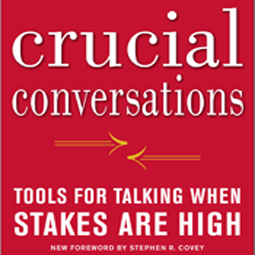7 Tips for Mastering Crucial Conversations
Published: Nov 07, 2011

Striking up a conversation with people can be hard, so a tough conversation that needs to be had – the kind where emotions run high and opinions greatly vary - can be downright scary. However, those who master the art of a difficult conversation are the ones who advance the furthest in their career. Whether it’s the difficult decision to announce budget cuts or to simply ask for a raise you know you deserve, those who choose to change the subject or avoid the conversation all together are the ones whose careers stall.
That’s the thought behind Crucial Conversations: Tools for Talking When Stakes Are High, a book written by four-time bestselling authors Kerry Patterson, Joseph Grenny, Ron McMillan, and Al Switzler. First published in 2002, Crucial Conversations has sold more than 2 million copies. Almost a decade later, McGraw-Hill has published a second edition with new content that – new research, updated facts and figures, skill applications, case studies and links to videos and other online resources.
The book does a good job at teaching people the art of how to have a true dialogue – the free exchange of multiple ideas that allow varying opinions to be put out in the open, along with accurate and relevant information necessary to make decisions. The book also helps readers prepare for high-impact situations; feel safe talking about almost any topic; be persuasive and not an abrasive personality no one would want to deal with; keep cool and calm in tough situations where others freak out or tune out; and in the end see the actions and results you wanted from the beginning.
The authors also offer seven effective steps to mastering a crucial conversation:
1. Start with Heart – What is the desired result from this conversation? What exactly is at stake? You have to ask yourself these questions to determine how important this conversation is to you and your career. Knowing what is at stake going into the conversation will help you stay true to your convictions.
2. Learn to Look – Be on the lookout for a lack of mutual purpose. Continuously ask yourself whether you are leading the conversation with dialogue or defensiveness. And if you or the other party strays toward the latter, protect your conversation from going downhill with an expression like “I think we’ve moved away from dialogue” or “I’m sorry. I’ve been trying to force my ideas on you.”
3. Make it Safe – When you notice that you and others have moved away from dialogue, do something to make it more comfortable. Ask a question and show interest in others’ views. Apologies, smiles, even a request for a brief “time out” can help restore safety when things get dicey.
4. Master your Story – Retrace your path to find out what facts are behind the story you’re telling. When you have the facts on your side, it’s hard to deny your argument.
5. State your Path – Share your facts and conclusions in a way that will make the other party feel safe telling their story, too.
6. Explore Others’ Path – A dialogue allows you to actively inquire about the other party’s views. Now that you both understand each other, you can emphasize which parts you agree upon and the areas in which you differ.
7. Move to Action – Come to a consensus about what will happen, document who does what by when and settle on a way to follow up.
The authors believe that mastering these steps reduced the failure of team projects by half and showed effective results in many other situations – both personal and professional. By knowing how to handle these crucial conversations, you can become influential; the type of person who can solve problems and get things done while also strengthening valuable relationships in the workplace.
Check out Crucial Conversations here.
--Jon Minners, Vault.com
